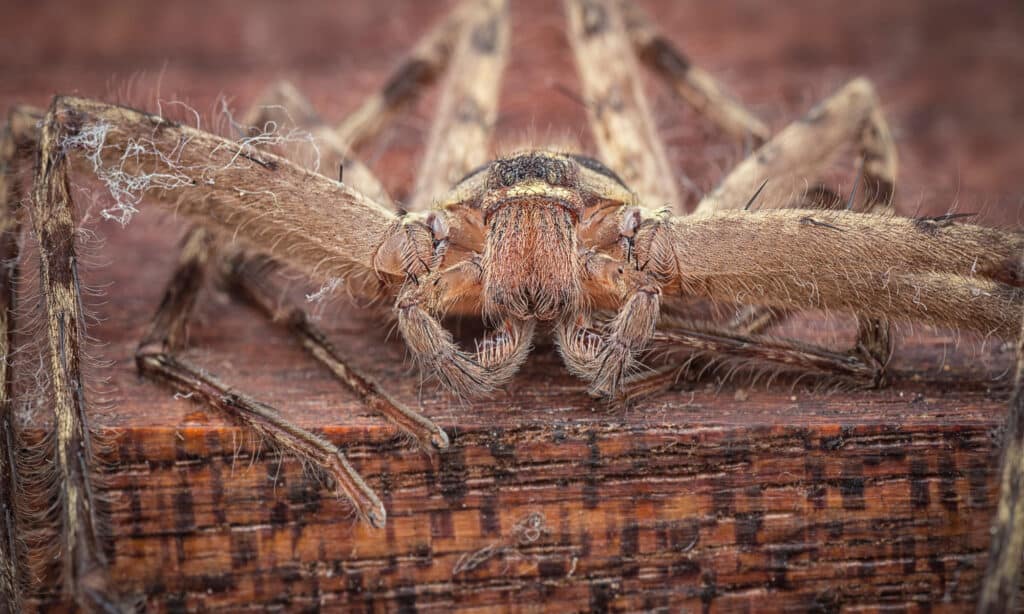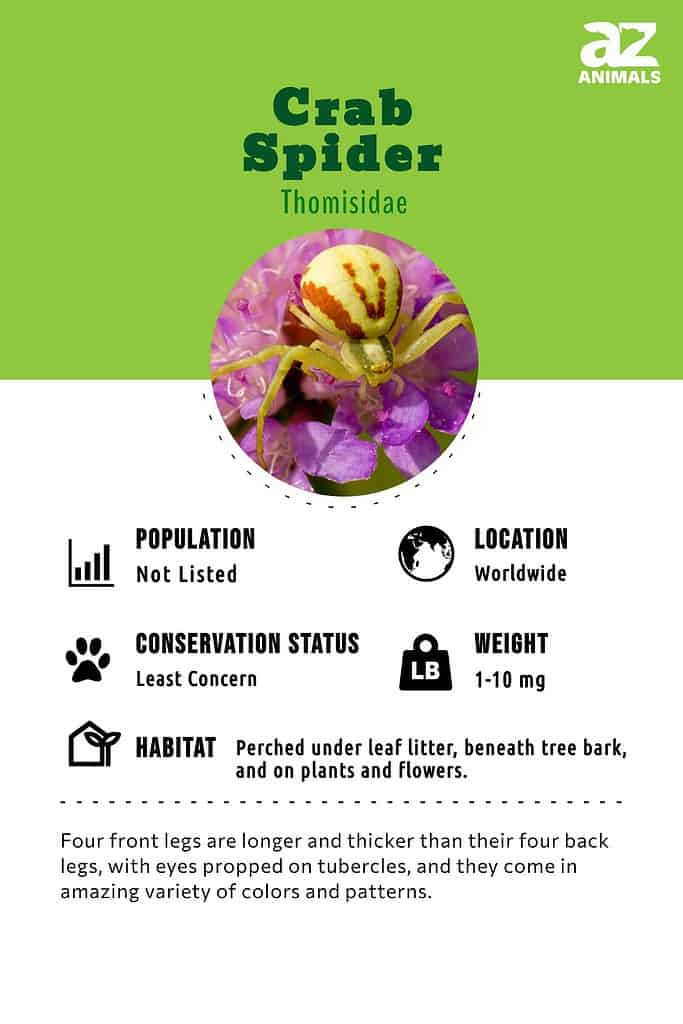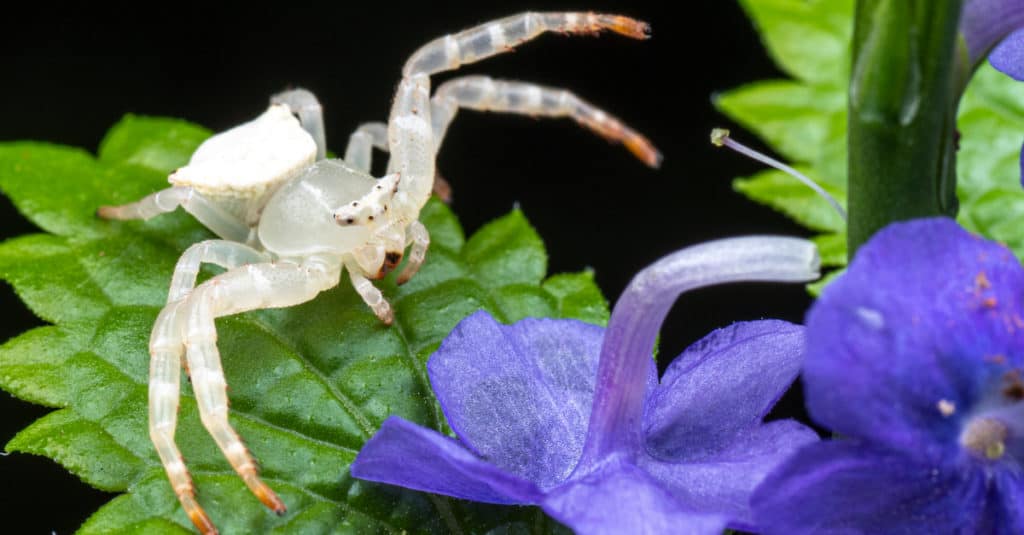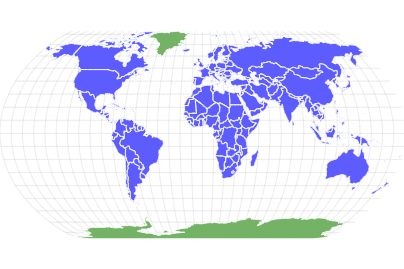Crab Spider
Crab Spiders can mimic ants or bird droppings
Advertisement
Crab Spider Scientific Classification
Read our Complete Guide to Classification of Animals.
Crab Spider Conservation Status
Crab Spider Facts
- Prey
- Other insects, flowers, pollen
- Fun Fact
- Crab Spiders can mimic ants or bird droppings
- Biggest Threat
- Parasites and other insects
- Distinctive Feature
- Crablike appearance
- Gestation Period
- 3.5 weeks
- Litter Size
- 2-1,000
- Habitat
- Gardens, meadows, woodlands, tropical rainforests, grasslands, marshes and scrublands
- Predators
- Wasps, ants, large spiders, lizards, birds and shrews.
- Diet
- Omnivore
- Lifestyle
- Diurnal
- Number Of Species
- 2100
View all of the Crab Spider images!
Crab Spiders can mimic ants or bird droppings
“They look like tiny crabs.”
Crab spiders are mostly found in the Thomisidae family, though other spiders known as crab spiders can be found in families such as Selenopidae, Sparassidae, and Sicariidae. These spiders include giant crab spiders such as the enormous Huntsman spider.
Crab spiders get their name because they hold their legs crabwise and can move backward and sideways as well as forwards. They are also called flower crab spiders or flower spiders because they can be found on flowers such as roses and goldenrod. They are also found on foliage and under bark or fallen leaves, waiting for prey.

Crab spiders get their name because they hold their legs crabwise and can move backward and sideways as well as forwards.
©Young Swee Ming/Shutterstock.com
3 Incredible Crab Spider Facts!
- Crab spiders don’t weave webs and are mostly ambush predators.
- They can change color to blend into their surroundings, though this can take a long time.
- Female crab spiders tend to be larger than males, and in species such as Misumena vatia, females are many times bigger than males.

Species, Types, and Scientific Name
The family name Thomisidae was bestowed by the French scientist Charles Athanase Walckenaer. The name derives from the Greek word thominx, which means “cord” or “string.” This is because the spider doesn’t make a web but relies on a single strand of silk. Female spiders deposit their eggs in an egg sac woven of silk or in a nest she weaves in a plant. Females guard their eggs and even the hatchlings until their second molt. The mother dies soon after. It’s probable that she killed and ate the father soon after mating.
Most female crab spiders stay on a plant or other staging ground waiting for prey, while the smaller males wander around.
There are 2100 species, around 175 genera, and hundreds of clades in the Thomisidae family. Among them are the Misumena, Bassaniana and Amyciaea genera.
- Goldenrod Crab Spider – Misumena vatia, known as the Golden Crab Spider, is found in the holarctic realm, which are habitats found north of the equator. They are famous for their ability to change color, though their “resting” color is white or yellow. These crab spiders can also be pink or pale mint green and even take on the color of their prey.
- Bark Crab Spiders – Bassaniana, also known as bark crab spiders, are found in North America, Europe, and Asia. They have the mottled brown, gray and black coloration that camouflages them among the black, brown, and gray tree bark where they wait for prey.
Crab spiders in the Amyciaea genus have evolved to mimic ants, particularly weaver ants.
- Weaver Ants – This spider tricks the ant into believing it is one of them, then kills and eats it. There are five species of Amyciaea ants, and they’re found in Oceania, Asia, and Africa.
Other genera in the Thomisidae family include:
- Xysticus with about 360 species
- Thomisops, with 10 species
- Loxobates, with 10 species
- Platythomisus with 14 species. With the exception of P. jucundus, all Platythomisus spiders are female or juveniles. All crab spiders in P. jucundus are male.
- Oxytate, which can turn bright green to camouflage itself in the grass or on a leaf. There are 26 species.
- Boomerangia, which is one of the latest genera to be discovered. This genus was discovered in Australia in 2014. There’s only one species so far, B. dimidiata.
- Phrynarachne spiders mimic bird droppings. There are 30 species in this genus.

The family name Thomisidae derives from the Greek word
thominx, which means “cord” or “string.”
©HWall/Shutterstock.com
Appearance
Crab spiders can be identified because their four front legs are longer and thicker than their four back legs. Like many spiders, they have eight eyes, and their eyes are often propped on tubercles. They have flat bodies, two claws, and legs that are held crabwise and allow them to run sideways. This is called laterigrade.
Besides this, crab spiders come in an amazing variety of colors and patterns. They come in shades of white and black, brown, sky blue, goldenrod yellow, cherry blossom pink, and leaf green with patterns of stripes, bands, spots, and blotches.
Generally, male spiders range from 0.079 to 0.276 inches long, while females range from 0.16 to 0.39 inches long.

Crab spiders can be identified because their four front legs are longer and thicker than their four back legs.
©iStock.com/GlobalP
History and Evolution
Crab Spiders have evolved to ambush their prey rather than spinning webs to capture them. They have adapted to have stronger front legs and are able to skitter around quickly in any direction, and this movement is from where they receive their name.
Some Crab Spiders have evolved the ability to physically change the color of their body to mimic whatever flower or plant they are perched upon. This adaptation has allowed them to survive in nature and capture their food.
Other Crab Spiders are able to shape their bodies, such as flattening them, in order to hide in tiny places and wait to ambush their victims.
Habitat

Crab spiders can be found just about anywhere in the world.
©Vinicius R. Souza/Shutterstock.com
Crab or flower spiders are found everywhere in the world save the coldest or driest places. They perch under leaf litter, beneath tree bark, and on plants and flowers. Crab spiders are found in the tropics, temperate forests, deserts that aren’t too dry, and on mountains that aren’t too cold.
Diet

Crab spiders feed on other insects.
©Peter Yeeles/Shutterstock.com
Crab spiders eat mostly insects that land too close to where they are hiding. Because their venom is potent for a spider of their size, they can capture insects much bigger than they are. These insects include crickets, grasshoppers, and wasps. Other insects include such pests as aphids, thrips, caterpillars, houseflies, fruit flies, whiteflies, other types of flies, and Japanese beetles, but they can also include beneficial insects such as butterflies and bees. Many crab spiders hunt at night such as the white crab spider, Thomisus spectabilis. Others hunt during the day. Because of their small size, crab spider are typically too small to hurt humans with a bite or venom.
Some flower spiders such as Thomisus onustus, the pink crab spider eat the nectar and pollen from the flowers they live on when prey is scarce.
View all 235 animals that start with CCrab Spider FAQs (Frequently Asked Questions)
Are crab spiders dangerous?
Crab spiders aren’t dangerous to humans, though they are quite venomous for their size. This venom allows them to take insects much larger than they are. At worst, a human may suffer a bite whose pain lasts a few hours, but the bite isn’t fatal.
How many legs does a crab spider have?
Like all spiders, crab spiders have eight legs. Interestingly, many spiders lose at least one leg during their lifetime, especially males. Losing one or two legs doesn’t affect their hunting prowess, however.
How do you identify crab spider?
A crab spider looks like a tiny crab. The first two pairs of its legs are much bigger than the other two pairs, and the spider can walk backwards, forwards and sideways.
What is a crab spider?
A crab spider is an arachnid, not an insect, that mostly belong to the Thomisidae family of spiders, though arachnids called giant crab spiders belong to other families.
Are crab spiders poisonous to humans?
Crab spiders are venomous, not poisonous. Their venom is not dangerous to humans. Most are simply too small for their fangs to even pierce the skin. The giant crab spiders of the Sparassidae family can make a person sick but usually not sick enough to go to the hospital.
Where are crab spiders found?
Crab spiders are found all over the world save the coldest and driest places. There aren’t any in Antarctica, for example.
Do crab spiders live in the UK?
Crab spiders do live in the United Kingdom. They include Misumena vatia
Are crab spiders good?
Crab spiders are very good at controlling the population of insect pests such as aphids. This is why it’s a good thing to see a crab spider in the garden.
What does a crab spider look like?
A crab spider looks like a tiny crab. They can be very colorful and hide by changing into the color of the plant they live on. They even change color according to the insect they eat.
What does a crab spider eat?
Crab spiders eat insects such as grasshoppers, crickets, aphids, whiteflies, wasps and fruit flies. Unfortunately, they also eat honey bees, bumblebees, butterflies and moths.
Thank you for reading! Have some feedback for us? Contact the AZ Animals editorial team.
Sources
- Brandeis, Available here: http://www.bio.brandeis.edu/fieldbio/Spiders_Savransky_Suhd_Brondstatter/Pages/Fam_Thomisidae.html
- Merriam-Webster, Available here: https://www.merriam-webster.com/dictionary/Thomisidae
- University of Kentucky Entomology, Available here: https://www.uky.edu/Ag/CritterFiles/casefile/spiders/crab/crab.htm
- Bug Guide, Available here: https://bugguide.net/node/view/87495
- Habitat News, Available here: http://habitatnews.nus.edu.sg/guidebooks/spiders/text/Amyciaea_lineatipes.htm
- Bug Guide, Available here: https://bugguide.net/node/view/1957/bgimage
- Bio Kids, Available here: http://www.biokids.umich.edu/critters/Thomisidae/
- Wikipedia, Available here: https://en.wikipedia.org/wiki/Thomisus_spectabilis
- Jungle Dragon, Available here: https://www.jungledragon.com/specie/76/thomisus_onustus.html
- Game and Wildlife Conservation Trust, Available here: https://www.gwct.org.uk/wildlife/species-of-the-month/2019/crab-spider/

















